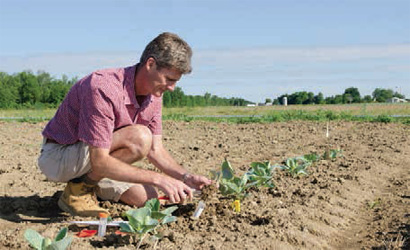Back in 1922, Bostonians welcomed their first shipment of broccoli, grown in San Jose, California, by two Italian brothers who’d carried treasured seed from their homeland. Today, the vitamin-dense crucifer anchors a $1 billion industry thriving in California, Arizona, and Mexico, which together harvest 90 percent of what Americans consume.

Green revolution: Professor Thomas Björkman tends his experimental plants.ROBYN WISHNA
Horticulture professor Thomas Björkman sees an opportunity for East Coast farmers in those numbers—especially given the price and quality advantages of local produce over veggies shipped cross-country in refrigerated trucks. Funded by a $3.2 million USDA grant and $1.7 million in corporate partnerships, Björkman heads a team of fifty farmers, plant breeders, economists, and marketing experts from Maine to Florida in a decade-long quest, now in its third year, to breed a better broccoli and establish the distribution and marketing channels to convey the crop from field to fork. “The USDA asked us to challenge ourselves in a big way,” says the biochemist. “We just might be able to pull this off.”
Like other cool-season brassicas—a genus of plants in the mustard family—broccoli has long been a staple of spring and fall farmers’ markets up and down the East Coast. But a hot, humid Atlantic summer wreaks havoc on the Mediterranean native, and grocers have opted for a steady supply of imports from distant climes. For Björkman’s team, then, the first step toward establishing a $100 million Eastern broccoli industry has been developing new varieties—in collaboration with three commercial seed companies—to facilitate a steady year-round harvest. The 2012 growing season, plagued by drought and hurricane, supplied rich data from all but one of thirty-one field trials. “Some of the hottest weather showed that the new stuff we have is going to hold up well,” says Björkman, who started investigating heat injury in broccoli in 1995. “The one field we lost wasn’t because of the weather; crows came along and pulled the transplants out of the ground.”
Even after they’ve tailored the vegetable’s basic biology to the East Coast and helped farmers transition their fields, the team will have a long row to hoe. Establishing a thriving regional distribution system will demand new infrastructure—to insure that the highly perishable harvest is promptly and thoroughly cooled—as well as resilient grower networks and consumers enthusiastic about buying broccoli grown closer to home. “All of those components have to change at the same time,” says Björkman. “If you do it piecemeal, you’ll make no progress.”


